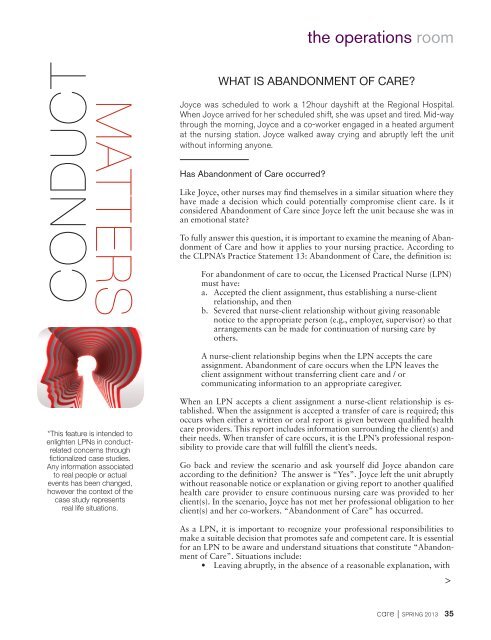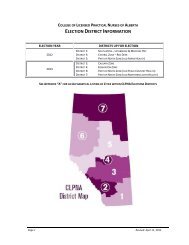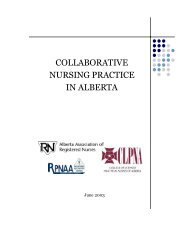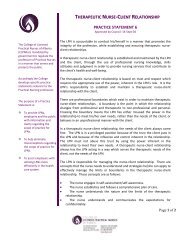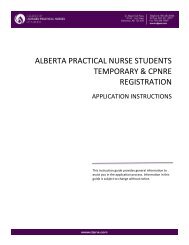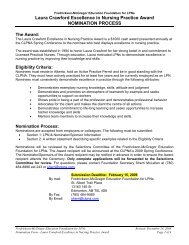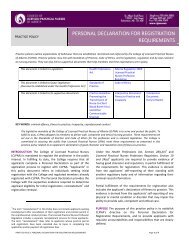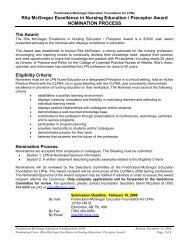Download PDF - College of Licensed Practical Nurses of Alberta
Download PDF - College of Licensed Practical Nurses of Alberta
Download PDF - College of Licensed Practical Nurses of Alberta
- No tags were found...
Create successful ePaper yourself
Turn your PDF publications into a flip-book with our unique Google optimized e-Paper software.
the operations roomMATTERSCONDUCTWhat is Abandonment <strong>of</strong> Care?Joyce was scheduled to work a 12hour dayshift at the Regional Hospital.When Joyce arrived for her scheduled shift, she was upset and tired. Mid-waythrough the morning, Joyce and a co-worker engaged in a heated argumentat the nursing station. Joyce walked away crying and abruptly left the unitwithout informing anyone.Has Abandonment <strong>of</strong> Care occurred?Like Joyce, other nurses may find themselves in a similar situation where theyhave made a decision which could potentially compromise client care. Is itconsidered Abandonment <strong>of</strong> Care since Joyce left the unit because she was inan emotional state?To fully answer this question, it is important to examine the meaning <strong>of</strong> Abandonment<strong>of</strong> Care and how it applies to your nursing practice. According tothe CLPNA’s Practice Statement 13: Abandonment <strong>of</strong> Care, the definition is:For abandonment <strong>of</strong> care to occur, the <strong>Licensed</strong> <strong>Practical</strong> Nurse (LPN)must have:a. Accepted the client assignment, thus establishing a nurse-clientrelationship, and thenb. Severed that nurse-client relationship without giving reasonablenotice to the appropriate person (e.g., employer, supervisor) so thatarrangements can be made for continuation <strong>of</strong> nursing care byothers.A nurse-client relationship begins when the LPN accepts the careassignment. Abandonment <strong>of</strong> care occurs when the LPN leaves theclient assignment without transferring client care and / orcommunicating information to an appropriate caregiver.*This feature is intended toenlighten LPNs in conductrelatedconcerns throughfictionalized case studies.Any information associatedto real people or actualevents has been changed,however the context <strong>of</strong> thecase study representsreal life situations.When an LPN accepts a client assignment a nurse-client relationship is established.When the assignment is accepted a transfer <strong>of</strong> care is required; thisoccurs when either a written or oral report is given between qualified healthcare providers. This report includes information surrounding the client(s) andtheir needs. When transfer <strong>of</strong> care occurs, it is the LPN’s pr<strong>of</strong>essional responsibilityto provide care that will fulfill the client’s needs.Go back and review the scenario and ask yourself did Joyce abandon careaccording to the definition? The answer is “Yes”. Joyce left the unit abruptlywithout reasonable notice or explanation or giving report to another qualifiedhealth care provider to ensure continuous nursing care was provided to herclient(s). In the scenario, Joyce has not met her pr<strong>of</strong>essional obligation to herclient(s) and her co-workers. “Abandonment <strong>of</strong> Care” has occurred.As a LPN, it is important to recognize your pr<strong>of</strong>essional responsibilities tomake a suitable decision that promotes safe and competent care. It is essentialfor an LPN to be aware and understand situations that constitute “Abandonment<strong>of</strong> Care”. Situations include:• Leaving abruptly, in the absence <strong>of</strong> a reasonable explanation, with>care | spring 2013 35


